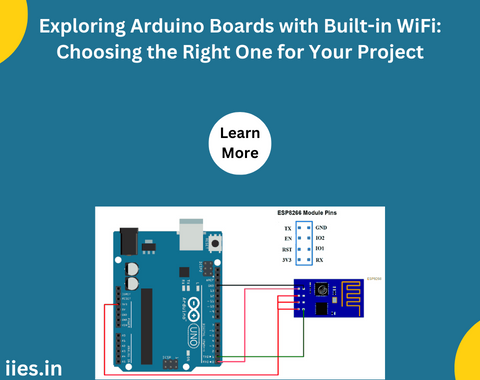
Arduino, the open-source electronics platform, has revolutionized the world of DIY electronics and prototyping. With a plethora of boards available, each catering to specific needs, Arduino has consistently adapted to technological advancements. One such crucial development is the integration of WiFi capabilities into Arduino boards, enabling seamless connectivity and communication. In this article, we’ll delve into the various Arduino boards equipped with WiFi and help you choose the right one for your project.
The Arduino Uno WiFi Rev2 stands as a bridge between the classic Arduino Uno and modern connectivity needs. Based on the ATmega4809 microcontroller, it combines the reliability of the Uno with the convenience of built-in WiFi. The on-board U-blox NINA-W13 module provides 2.4GHz WiFi connectivity, making it suitable for IoT projects, home automation, and remote sensing applications.
The Uno WiFi Rev2 retains the compatibility with existing Arduino shields, making it an excellent choice for those transitioning from traditional Arduino projects to ones requiring wireless connectivity. Its compatibility with the Arduino IoT Cloud further simplifies the development process for remote monitoring and control.
Arduino Nano 33 IoT: Compact Powerhouse for IoT Projects:
For those looking for a compact solution with integrated WiFi, the Arduino Nano 33 IoT fits the bill. The Nano 33 IoT is a small-sized board that boasts the power of the SAMD21 microcontroller and the secure connectivity of the NINA-W10 WiFi module. Despite its compact size, it offers a rich set of features, including a 6-axis IMU, making it suitable for projects requiring motion sensing and IoT applications.
The Nano 33 IoT supports the Arduino IoT Cloud and is programmable using the Arduino IDE. Its small form factor makes it an ideal choice for wearable devices, smart sensors, and other projects where space is a critical factor.
Arduino MKR WiFi 1010: Professional-Grade WiFi Connectivity:
When professional-grade WiFi connectivity is essential, the Arduino MKR WiFi 1010 steps in as a reliable and powerful option. Built around the SAMD21 microcontroller and the U-blox NINA-W102 module, this board is designed for high-performance IoT applications. Its low power consumption and crypto-authentication features make it suitable for secure and energy-efficient projects.
The MKR WiFi 1010 offers a variety of communication options, including WiFi, BLE (Bluetooth Low Energy), and traditional GPIOs, making it versatile for a wide range of applications. With the MKR form factor, it’s compatible with the MKR family of shields, expanding its capabilities further.
Arduino MKR1000: Legacy Board with WiFi Connectivity:
The Arduino MKR1000, although not the latest in the MKR series, remains a relevant choice for projects requiring WiFi connectivity. Powered by the ATSAMW25 module, it combines the functionality of the ATmega32U4 microcontroller and a WiFi module on a compact board. The MKR1000 is designed for low-power applications, making it suitable for battery-operated projects.
While newer MKR boards have surpassed the MKR1000 in terms of features, its legacy status makes it a cost-effective solution for simple IoT projects and applications where power consumption is a critical consideration.
Arduino Mega 2560 WiFi: Power and Connectivity Combined:
For projects demanding a higher number of digital and analog I/O pins along with WiFi connectivity, the Arduino Mega 2560 WiFi is the go-to choice. This board retains the classic Mega form factor while incorporating the ATmega2560 microcontroller and the ESP32-based U-blox NINA-W102 module for WiFi connectivity.
With 54 digital I/O pins, 16 analog inputs, and robust processing power, the Mega 2560 WiFi caters to complex projects such as 3D printers, robotics, and automation systems that require extensive interfacing capabilities.
Arduino Due with WiFi Shield: Legacy Power with Added Connectivity:
The Arduino Due, known for its powerful ARM Cortex-M3 processor, can be paired with WiFi Shields to add wireless capabilities. While the Due itself does not have built-in WiFi, the compatibility with the WiFi Shield opens up the possibility of integrating WiFi connectivity into high-performance projects. This combination is suitable for applications where the processing power of the Due is a prerequisite, and WiFi functionality is needed.
The Due, with its 32-bit architecture and expanded memory, caters to projects with demanding computational requirements, such as signal processing, data logging, and real-time control. Adding the WiFi Shield provides the best of both worlds—raw processing power and wireless connectivity.
ESP8266 and ESP32: Standalone WiFi Modules for Arduino:
In addition to Arduino boards with built-in WiFi, standalone WiFi modules like the ESP8266 and ESP32 have gained immense popularity in the maker community. While not Arduino boards per se, these modules can be programmed using the Arduino IDE, allowing for seamless integration into Arduino projects.
The ESP8266, known for its low cost and simplicity, is an excellent choice for basic IoT applications. On the other hand, the ESP32 offers a more powerful solution with dual-core processors, Bluetooth support, and a variety of GPIO pins. Makers often choose these modules when flexibility, cost-effectiveness, or specific project requirements dictate the need for standalone WiFi modules.
Choosing the right Arduino board with built-in WiFi depends on the specific requirements of your project. Whether you’re a beginner exploring the world of IoT or an experienced maker working on a sophisticated automation system, Arduino offers a diverse range of options to meet your needs. Consider factors such as form factor, processing power, connectivity options, and compatibility with existing shields when selecting the ideal Arduino board for your next wireless project. As technology continues to evolve, Arduino remains at the forefront, empowering makers and developers to bring their innovative ideas to life.
Indian Institute of Embedded Systems – IIES